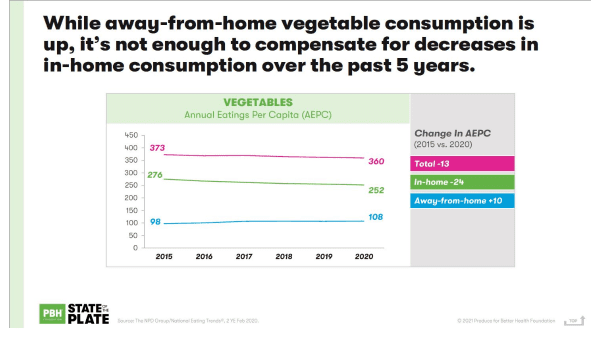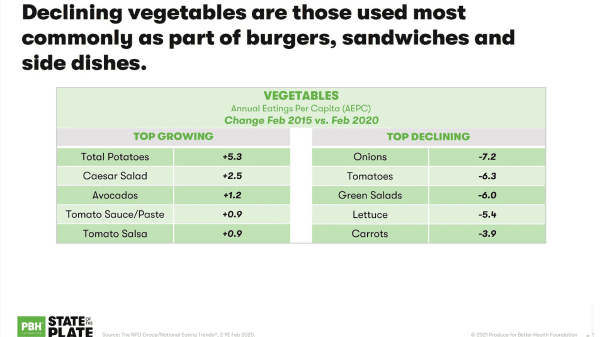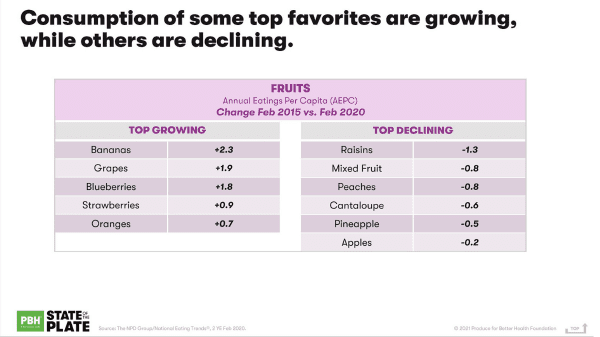You should be concerned if you looked at the data in the State of the Plate: America’s Fruit and Vegetable Consumption Trends research released this week by the Produce for Better Health Foundation BB #:157162.
Americans are eating fruits and vegetables less frequently in the past 15 years, with overall instances down 10 percent and vegetables down 16 percent.

In the past five years, total produce consumption is down 3 percent with vegetables down 4 percent. Meanwhile, fruit consumption frequency is up 10 percent in 15 years and up 3 percent in the past five.
Wendy Reinhardt Kapsak, RDN, and president and CEO of PBH, pointed out that this study was done pre-pandemic, so there could be some changes in the past 12 months.
The study looks into annual eatings per capita, so how many times people eat something like a fruit or vegetables with a meal. That means in 2020, the average eating of vegetables was 360, or about once a day, and fruit was 206, or about twice every three days.
The problems with vegetables
Focusing in on vegetables, we find among the most troubling of the data.

Eatings of veggies dropped 13 overall from 2015 to 2020, from 373 to 360, which means from more than one a day to less than one a day. In-home dropped more dramatically from 276 to 252, while away-from-home rose from 98 to 108.
The top five vegetable gainers were potatoes (+5.3), Caesar salad (+2.5), avocados (+1.2), tomato sauce/paste (+0,9) and tomato salsa (+0.9).
The five declining the most were onions (-7.2), tomatoes (-6.3), green salads (-6.0), lettuce (-5.4) and carrots (-3.9).
Kapsak noted that there are several things that stand out for the items declining.

“Burgers and sandwiches are how most people get their vegetables, and a lot of people are just leaving that stuff off,” she said.
She also said convenience is a factor. All those vegetables require some preparation.
“Is a millennial buying a head of lettuce and cutting a tomato and onion for a burger or sandwich?” she said.
The good news in fruit
Annual eatings of fruit gained slightingly by 5 from 201 to 206, and it was all picked up in the eating-at-home segment, as away-from-home was flat.
By item, the top gainers were bananas (+2.3), grapes (+1.9), blueberries (+1.8), strawberries (+0.9) and oranges (+0.7).
The decliners were raisins (-1.3), mixed fruit (-0.8), peaches (-0.8), cantaloupes (-0.6), pineapples (-0.5) and apples (-0.2).

“The gainers have ease and grab-and-go potential,” Kapsak said, noting that snacking was the No.1 fruit eating occasion.
The oranges segment includes easy-peel citrus, she said.
Kapsak said the data shows that the country has a crisis, and before the COVID-19 pandemic, many Americans had an obesity crisis that can be improved by increasing fruit and vegetable consumption.
She said the produce industry must continue to make their products easier to consume and then encourage people to choose easy, favorite, and accessible fruits and vegetables and increase their eating occasions by one serving per day.
The produce industry has to come to terms that produce consumption is a crisis, and the problem isn’t educating people (PBH’s survey showed 52 percent of people said they were trying to increase their fruit intake and 56 percent said that of vegetables, which were down 1 point each from five years earlier).
The solution will be one of motivation.


